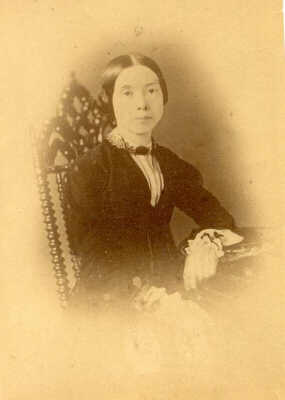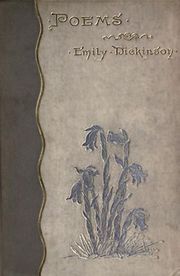|
Reading Emily Dickinson 
1830–86 American poet Realaudio Player Emily Dickinson, regarded as one of America’s greatest poets. She is also well known for her life of seclusion. Her work questioned the nature of immortality and death. Within short, compact phrases she expressed far-reaching ideas. Emily Dickinson was born on 10th December, 1830, in the town of Amherst, Massachusetts. Amherst is 50 miles from Boston. Her family were pillars of the local community. She was the second child born to Emily Norcross (1804-1882) and Edward Dickinson (1803-1874), a Yale graduate, successful lawyer, Treasurer for Amherst College and a United States Congressman. Emily had an older brother named William Austin Dickinson (1829-1895) (known as Austin) who would marry her most intimate friend Susan Gilbert in 1856. Her younger sister’s name was Lavinia ‘Vinnie’ Norcross Dickinson (1833-1899). As a young child, Emily proved to be a bright and conscientious student. She showed a sharp intelligence, and was able to create many original writings of rhyming stories, delighting her fellow classmates. Emily said of her father. “his heart was pure and terrible”. His strictness can be shown through his censorship of reading materials. Religious Influence Religion was the “all important question” fore Dickinson. Her antecedents had left England, so they could practise religious freedom in America. The East coast, saw a revival of strict Calvinism. Amherst College itself was founded with the intention of training ministers to spread the Christian word. Emily was a bright conscientious student. At Mount Holyoke Female Seminary in South Hadley, she was able to study a range of subjects from Latin to English Literature. However, her studies were often interrupted by ill health. After a persistent cough developed, her father decided to remove her from college and bring her back home. Thus she left without any formal qualifications, but she had at least been able to broaden her education and vocabulary. Emily Dickinson’s later seclusion from society gives an impression of a life of austerity and simplicity. This has been romanticised, with the frequently cited preference for her wearing all white dresses. However, Emily was both a keen artist and accomplished musician. In her college years she enjoyed singing; making reference to the similarities between poetry and singing. She also had a sharp eye for beautiful art; this visual sense and her appreciation of bright colours being evident in many of her poems. Emily was also well read, choosing writers such as; Emerson, Thoreau, Dickens, John Ruskin, and nineteenth- century poets like the Browning’s and the Bronte sisters. The poetry of Emerson was introduced to Emily by one of her brother’s friends, Benjamin Newton. Newton was a young law student, who was well versed in contemporary literature. He was one of the first people to recognise the poetic capacities of Emily, and encouraged her to write poetry. The works of other poets, in particular Emerson, were important for Emily Dickinson in opening up spiritual ideas beyond the strict Calvinism. Emily had innovative views and unorthodox beliefs, but she often doubted her own convictions; thus influences of Emerson and other poets were of great importance. Poetry Emily Dickinson is considered one of the most original 19th Century American poets. She is noted for her unconventional broken rhyming meter and use of dashes and random capitalisation as well as her creative use of metaphor and overall innovative style. She was a deeply sensitive woman who questioned the puritanical background of her Calvinist family and soulfully explored her own spirituality, often in poignant, deeply personal poetry. She admired the works of John Keats and Elizabeth Barrett Browning, but avoided the florid and romantic style of her time, creating poems of pure and concise imagery, at times witty and sardonic, often boldly frank and illuminating the keen insight she had into the human condition. At times characterised as a semi-invalid, a hermit, a heartbroken introvert, or a neurotic agoraphobic, her poetry is sometimes brooding and sometimes joyous and celebratory. Her sophistication and profound intellect has been lauded by laymen and scholars alike and influenced many other authors and poets into the 21st Century. There has been much speculation and controversy over details of Dickinson’s life including her sexual orientation, romantic attachments, her later reclusive years, and the editing and publication of various volumes of her poems. This biography serves only as an overview of her life and poetry and leaves the in-depth analysis to the many scholars who have devoted years to the study of Emily Dickinson, the woman and her works. As well as writing over 1,700 poems, Emily was a prolific letter writer; these letters giving her the opportunity for contact with others, that in other respects she denied herself. Her letters show her love of language and are often not too dissimilar to her style of poetry. She went to great length to express her personal sentiments of gratitude and love to others. Her letters to her sister in law Sue have often been interpreted as love letters, leading to speculation over her sexual bias. But it must be remembered this emotional style of writing and communicating was fairly common for the time. They should also be seen in regard to Emily’s other letters, which freely express intense emotional sentiments. Many of her poems refer to an invisible lover, - an object of devotion. Biographers have inevitably speculated about who this is. There is strong evidence that towards the end of her life she had some kind of emotional relationship with Judge Otis Lord (many years her senior and highly respected within the community). However, the poetry of Emily Dickinson was often deliberately vague. The object of her devotion may have been no person in particular, but some unknown aspect of the divine. Emily Dickinson died at the age of 55 from Bight’s disease, which is caused by kidney degeneration. After her death, her sister Vinnie, came across a box of 1,700 of Emily’s poems. Vinnie handed them to Mabel Todd. She typed up 200 letters becoming increasingly enthusiastic about the beauty and power of the poems. With the help and encouragement of Terrence Higginson, the first edition of poems was published in 1893. |

First Edition of poems, published in 1893 Sunset Why Death & Life Grass Mountain Clock Summers Day Garden Road Winds Visit Nature The Shelter Indian Summer Two_Voyagers Indian Summer Aristocracy Victory Letter To The World |
